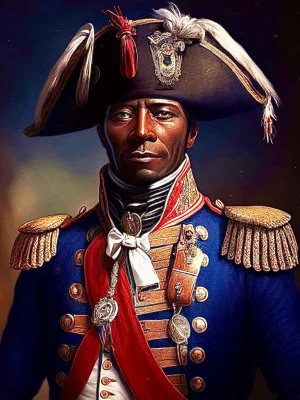Haytian
History
Honoring Hayti’s history of survival against overwhelming odds as it cultivates the tenacity to overcome countless challenges


The Haytian Story
"With your help, we can effectively form a coalition of diverse allies committed to re-engineering Haytian politics!"
Executive Summary
Hayti, the first independent nation in Latin America and the Caribbean, declared its independence from French colonial rule on January 1, 1804. However, the international recognition and acceptance of Hayti’s sovereignty have been uneven, and its independence has often been challenged. This policy brief argues for the acknowledgment and renewal of Hayti’s independence, highlighting the benefits for Hayti and the broader international community.
Background
Hayti’s declaration of independence in 1804 marked a historic moment in the struggle against colonialism and slavery. Led by revolutionary figures such as Jean-Jacques Dessalines and Henri Christophe, Hayti’s independence was a beacon of hope for oppressed peoples around the world. Despite this, Hayti has faced significant challenges in asserting and maintaining its independence, including political instability, economic crises, and external interventions.
Pre-revolutionary Hayti
Overview of Hayti’s History Before Independence:
Hayti, originally known as Saint-Domingue, was a French colony established in the late 17th century. It became one of the wealthiest colonies in the Americas due to its production of sugar, coffee, and indigo, driven by an extensive system of enslaved labor. By the 18th century, Saint-Domingue was the most profitable colony in the world, largely relying on the brutal exploitation of enslaved Africans.
Establishment of a Slave Colony and Bartholomew de las Casas:
Bartholomew de las Casas was a Spanish Dominican friar who initially advocated for the use of indigenous labor in the New World but later became a vocal critic of the atrocities committed against indigenous peoples. His shift in perspective led him to promote the importation of African slaves as a solution to the labor crisis in the Spanish colonies. Although de las Casas did not directly establish the slave system in Hayti, his advocacy for African slavery contributed to the broader acceptance and institutionalization of slavery throughout the Caribbean. The inhumane conditions and brutal treatment of enslaved people laid the foundation for the discontent that would ultimately fuel the Haytian Revolution.
The Haytian Revolution
Split Between Georges Biassou and Toussaint Louverture:
The Haytian Revolution (1791-1804) was a complex struggle for freedom involving various leaders, including Georges Biassou and Toussaint Louverture. Initially united against colonial rule, differing visions for the future of Hayti led to a rift. Biassou favored a more conservative approach aligned with Spanish interests, while Louverture sought to establish a more independent and egalitarian society, ultimately aligning with the French against the Spanish. This division contributed to the broader geopolitical split of Hispaniola into Spanish-controlled Santo Domingo and French-controlled Saint-Domingue.
Significance of the
Monarchy:
Henri Christophe’s reign was marked by efforts to develop the nation, including building infrastructure and establishing a central government. However, his authoritarian rule and the heavy taxation imposed to fund these projects sparked discontent among the populace.
Detailed Account of the Revolution:
The revolution began with a slave uprising in 1791, marked by significant battles and shifting alliances. Louverture emerged as a prominent leader, implementing social reforms and military strategies that strengthened the revolutionary cause. In 1804, after years of conflict, Hayti declared independence, becoming the first nation to abolish slavery and the second independent republic in the Western Hemisphere. The establishment of a monarchy under King Henri Christophe in 1811 symbolized an attempt to bring stability and order to the nascent nation, though it also reflected the tensions between revolutionary ideals and the realities of governance.
Monarchy’s Role in Post-Independence Hayti
Early Years of Independence:
After independence, Hayti faced immense challenges, including international isolation, economic hardship, and internal divisions. The monarchy played a crucial role in navigating these challenges, attempting to assert Hayti’s sovereignty and legitimacy on the global stage. King Christophe implemented various reforms aimed at stabilizing the economy and improving education, albeit with a focus on consolidating power.
Role in Nation’s Development:
The monarchy sought to establish a national identity and pride through cultural and architectural initiatives, such as the construction of the Citadelle Laferrière and Sans-Souci Palace. Despite its eventual collapse in 1820, the monarchy’s efforts laid some groundwork for Hayti’s development and national cohesion.
Modern Relevance
Adapting Ideals and Values:
The ideals and values of the Haytian monarchy, such as national sovereignty, self-determination, and a commitment to social justice, can be adapted to contemporary Hayti. In a modern context, these principles could inform policies that prioritize national security, economic development, and social equity.
Alignment with Current National Security and Public Policy Priorities:
Modern Hayti faces significant challenges, including political instability, economic vulnerability, and social unrest. Adopting a framework that emphasizes local governance, community engagement, and sustainable development could address these issues. By drawing on the historical resilience and aspirations of the Haytian people, contemporary leaders could cultivate a national identity that honors the past while addressing present and future challenges.
Why acknowledge Hayti's independence?
Sovereignty and Self-Determination:
- Acknowledging and renewing Hayti’s independence reaffirms the principle of sovereignty and self-determination, which are fundamental rights enshrined in international law.
- It empowers the Haytian people to govern their own affairs and determine their own destiny without external interference.
Symbol of Resistance and Liberation:
- Hayti’s independence symbolizes the resilience and courage of enslaved Africans who fought for their freedom and dignity.
- Recognizing Hayti’s independence honors the sacrifices made by those who fought against colonial oppression and slavery.
Global Solidarity and Unity
- Recognizing Hayti’s independence fosters global solidarity and unity in the fight against colonialism,
imperialism, and racism. - It demonstrates a commitment to upholding the principles of equality, justice, and solidarity on the
international stage.
Economic Development and Social Progress
- Acknowledging Hayti’s independence opens up opportunities for economic development and social progress.
- It encourages international investment and cooperation, leading to job creation, infrastructure development, and poverty reduction.
Promoting Democracy and Human Rights:
- Supporting Hayti’s independence strengthens democratic governance and respect for human rights in the region.
- It sends a clear message that the international community values and supports democratic transitions
and institutions in Hayti.
